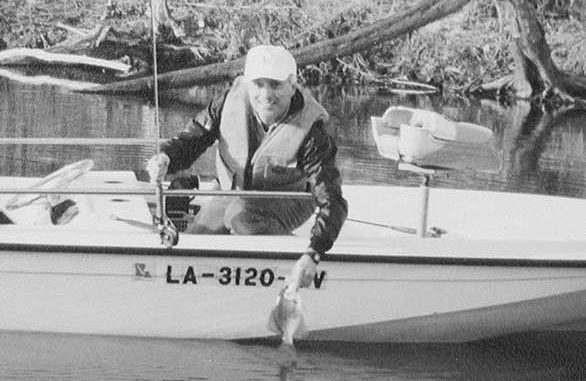
If you’re tired of sitting in a stand or blind, and want to get out, walk around and have some action, this is the month for you.
Patrick McManus, author and long-time columnist for Outdoor Life and Field & Stream magazines, once observed that the two best times to fish are “when it’s rainin’ and when it ain’t.”
My own observation is that when it’s bright and sunny, bluegill bite best. That’s why they call them sunfish. When the weather is heading down the toilet, white perch bite best. That’s why they call them crappie.
As the days get longer, and Gulf moisture returns to collide with colder air, there are many crappie days to choose from. My logs reveal some memorable trips in February where raingear and wool caps were worn. Of course, whatever misery I was put through was rewarded by fine feasting at the dinner table.
If the value of this fish were measured only by the palate, it’d be hard to argue with just getting a few shiners and reverting to some “commie” fishing. Or even worse, some “Al Qaida” fishing — setting up yo-yos off trees and piers.
But I find this species to be both fun and challenging on fly rod. The key to success involves great patience, the use of sensitive tackle and, more important, a willingness to experiment.
Not much is written on fly fishing for crappie. In fact, they’re usually grouped with bluegill and other centrachids under the general category of “panfish.” There’s just one small problem with that generalization … it’s stupid!
Crappie are as different from bluegill as speckled trout are from redfish. In fact, they have a lot more in common with speckled trout.
Let’s examine that last statement. As previously mentioned, crappie are more active during low-light periods. They feed mostly on baitfish. During cold weather, they concentrate in deep water. They’re active at night, and feed under lights.
Yep, sure sounds like speckled trout to me.
With that in mind, the strategy is very simple: Borrow a few pages from the speckled trout handbook.
Take for example the typical reports that come out of Toledo Bend this time of year, that the fish are suspended in 10 to 15 feet of water, or more. A lot of fly anglers consider these fish untouchable, but that’s not true.
In saltwater, we use sinking lines to get to this depth when going after specks offshore or in deep canals and pits during winter.
In reservoirs, a sinking line provides the means to target suspended fish near bridges, or on dropoffs along old creek beds.
Some of the flies that work best with this approach include a couple of speck favorites – the Pink Charlie and the Clouser Minnow.
The first spawn of the year occurs in the ponds, canals and backwater bayous of the parishes along and south of the Intracoastal Waterway. Here, “deep water” is anything greater than 6 feet. Here, I employ a different speckled trout strategy — suspending a minnow pattern 18 to 24 inches under a half-a-cigar perch float, or as it’s better known, a VOSI.
In saltwater, the VOSI is the fly rodder’s popping cork. That is, the wider end points to the fly line, and when line is stripped hard, the VOSI makes a popping sound that attracts fish.
But when used in fresh water, the narrow end should point to the fly line. We want to make tiny strips, then pause, with barely enough movement to “ripple” the cork on the surface. This action gives the fly underneath its most appealing motion.
The float also acts to suspend the fly, for as long a period as possible, near structure that holds fish. Flies will get hung up at times, and are difficult to retrieve with a cork on the leader. So for freshwater use, I usually make a slit in the float, so it can readily be taken off.
In smaller lakes, backwaters, and ponds, some of the best flies are 1/80- to 1/120-ounce microjigs or fluff butts.
Many folks tell me they can’t find fluff butts in the fly shops. Yes you can … buy a beadhead wooly bugger and cut off the body hackle, and you have a fluff butt. That’s all it is — bead head, marabou tail and chenille body.
The more sophisticated fluff butts created by Gary Peterson utilize metallic braid and other synthetics for the body of the fly, giving it an even more minnow-like appearance.
If you want the fly to have a natural movement, you need to use a long, thin tippet between float and dropper. The maximum I ever use is 4X.
In fact, the butt section of my leader never exceeds 1X, so as to give as much sensitivity to the float as possible.
Turning over such a limp leader is possible if you use a slow- to moderate-action fly rod. Fast-action rods are good for casting tight loops, which is NOT what you want when casting dropper systems. Unless of course, you absolutely enjoy spending time on the water untangling a mess.
Also, a rod that flexes into the butt section, advertised to protect light tippets, in this case protects against the fly tearing out of the fish’s paper-thin mouth.
Looking for a moderate-action rod? You’ll find most are inexpensive. My favorite is any of the Orvis rods with flex rating of 6.0 or less, in 5-weight or less. Other picks include the Temple Fork Series 1, the St Croix Premier, the Redington Redfly and the Cabelas 3 Forks. All these sell for under $100.


